#Spotted Unicornfish
Explore tagged Tumblr posts
Note
I love your blog, could you post animals related to fantasy?
I give you a unicorn, a dragon, and the dreaded basilisk...
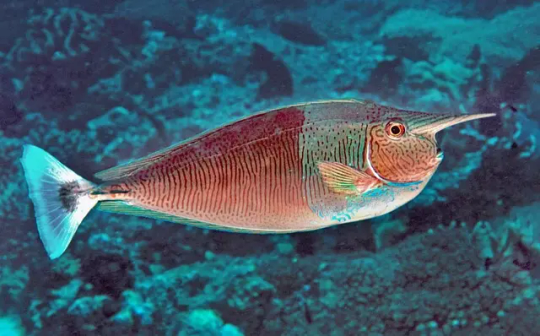
Spotted Unicornfish (Naso brevirostris), family Acanthuridae, order Acanthuriformes, found in the Indian Western Pacific Oceans
The unicorn horn on the unicornfish is called a "rostral protuberance", and no one really understands why they have them.
photograph by Paddy Ryan

Komodo Dragon (Varanus komodoensis), family Varanidae, found on Koomodo Island and other nearby islands in Indonesia
Venomous.
ENDANGERED.
It was once thought that Komodos subdue prey with a heavy and noxious array of mouth bacteria that infect bite wounds of prey after being bitten, but... it was never really determined scientifically if that's what was happening (conclusively, at least).
It turned out, they're venomous! Research was done in 2009 that found a primitive venom gland at the back of the mouth.
This is that largest species of lizard in the world, growing to a maximum total length of up to ~ 3 m (~10 ft.) long and a max. weight of up to 8~ 81 kg (180 lbs) (in the wild).
photograph by Andrew Yates
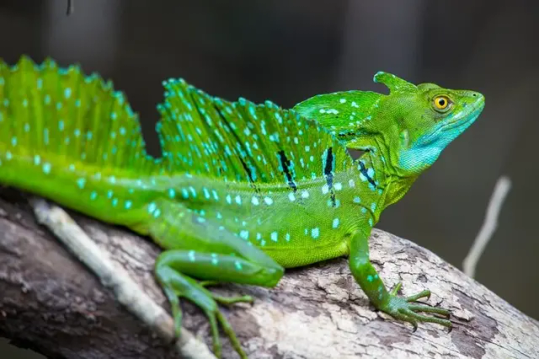
Green��or Plumed Basilisk (Basiliscus plumifrons), male, family Corytophanidae, Nicuragua
Basilisks are capable of running across the water's surface to escape predators (sometimes called the Jesus Christ Lizard).
Photograph by eco2drew
#unicorn#unicornfish#fish#komodo dragon#dragon#lizard#monitor lizard#reptile#basilisk#herpetology#ichthyology#animals#nature
269 notes
·
View notes
Text
also the FUNNIEST goddamn thing happened at the aquarium
i was standing next to a tank and saw a Bignose Unicornfish, which looks like this:

and i was like
"wow, that one has a really big nose" (I was unaware of the name at the time)
and IMMEDIATELY as I said that, as if on cue, THIS fucker zooms across the tank to swim right in front of me:

I was on the floor laughing.
This one, is, of course, called the Spotted Unicornfish. Why!!!!
#these pictures are not mine btw this is just the closest approximation#i got a picture of the bignose one (in my last post) but the other one would not sit still long enough to be photographed#animals#laughing
11 notes
·
View notes
Text
I like Pokémon and as my post history can tell you, I like fish. So why not combine the two and talk about fish Pokémon? I’m going to go over the real life inspirations for every fish Pokémon, discussing their biology and cool facts about the real inspirations. I’ll do this in parts so it doesn’t get too long. Today let’s do generation I and II.
The first fish we get in national dex order is the Horsea line and these aren’t too hard to figure out. They’re seahorses, some of the weirdest fish out there. Seriously, real seahorses are way weirder than Pokémon. We’re talking about fish that can barely swim, have prehensile tails, mate for life, the males get pregnant, and they have no stomachs but have the highest hunting success rate of all fish. Horsea has nothing on that. Horsea can also shoot water and ink from its mouth. This seems to be a reference to squid ink and water guns, though Horsea’s RB dex entry says they use precision shots to shoot down flying bugs. This was likely inspired by the archerfish, which does exactly that. This won’t be the only time that archerfish come up in this series. Their category as the dragon pokemon and Kingdra’s dragon typing references the Japanese word for seahorse, tatsu-no-otoshigo, which means “dragon’s child” based off of a myth that a seahorse who lives long enough will become a dragon. Kingdra also seems to have some weedy sea dragon influence, but there’s a better example of a Pokémon based on that much later in the series.
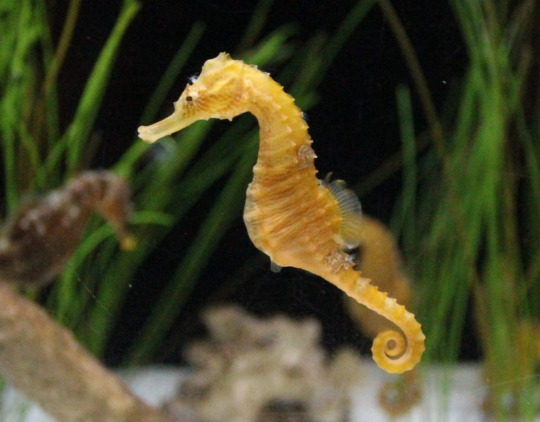
(image description, a seahorse)
So many recurring archetypes in the series can be traced back to gen I. Archetypes like the early game bird, the early game bug, the early game rodent, the mushroom, the three-stage rock, and more came from RBY. Another, probably less intentional archetype is the incredibly forgettable fish. Meet Goldeen and Seaking. They’re based on goldfish and koi and the only thing that makes them stand out from real fish is the horns. There are a truly absurd number of goldfish breeds but the one that looks closest to Goldeen is the tosakin, which has a curly tail like Goldeen and is popular in Japan while Seaking looks most like an azuma nishiki.

(image description: a tosakin Goldfish)
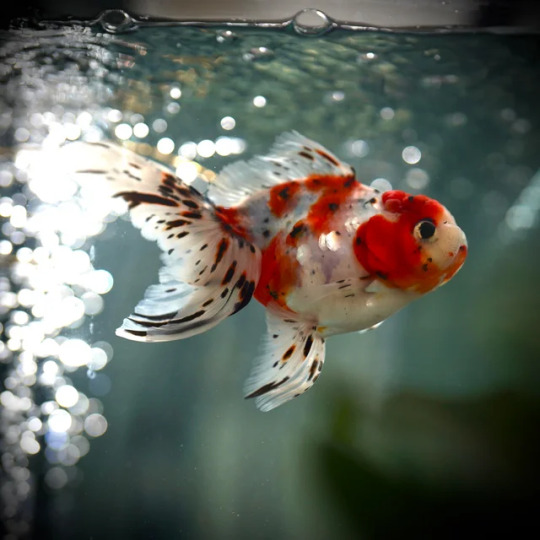
Since goldfish and koi are both members of the carp family, I wonder if there’s a close ancentral relationship to Magikarp. They are also said to swim upriver to spawn and Seaking gets redder during mating season, which seems to be a clear reference to salmon. In addition, male Seaking uses its horn to make a hole in a rock for the female to lay her eggs in. many male fish will make nests or other structures to woo females and provide a a safe spot to lay eggs. The horn is interesting. At first I thought I was just there to make them look less like normal fish, but there might be more to it than that. There are fish with horns, the cowfish, but they look nothing like these two (and barely look like fish for that matter) so I don’t think that was an inspiration. The unicornfish has a horn-like protrusion on its head that could have been an inspiration. I also found refences to Hinduism with Matsya, an avatar of Vishnu that looked like a horned fish in some depictions which could also be a reference in the line’s design (sidenote, a India-based region would be really cool).
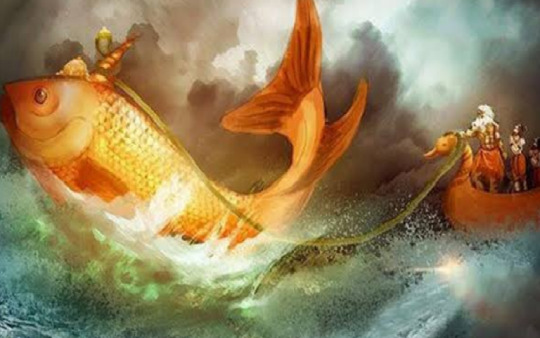
(mage description: an artistic depiction of Matsya as a horned fish)
These fish are found in a ton of regions despite not being all that interesting. In real life goldfish have become invasive or introduced species in many areas due to irresponsible pet owners releasing them into the wild. As these two are sometimes kept as pets, I wonder if their wide distribution in the Pokémon world is due to the same thing. Also, why is fresh water fish named Seaking?
Next we move on to the mon, the myth, the legend: Magikarp. I’m only going over Magikarp as I see Gyarados as a sea serpent/eastern dragon rather than a fish. Magikarp is, as you might guess, an Asian carp, though it also seems to have some koi features.

(image description: a common carp)
The common carp is somewhat golden in color, which could explain Magikarp’s shiny color, and mirror carp and koi have been specially bred for appearance, which might be why Magikarp is red. Magikarp is famous for its splashing and jumping, something Asian carp are also known for. Silver carp in particular can jump clear out of the water, which makes them a hazard for boaters.
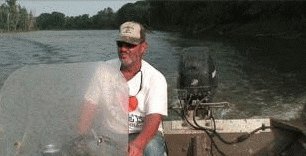
(gif description: a silver carp jumping out of the water and hitting a boater in the head)
Most pokedex entries focus on the splashing and how weak Magikarp is, but some go on to say their survival in the Pokémon world is due to them being able to live in very poor water quality and reproducing like crazy. This is very true of real Asian carp, who can thrive in terrible conditions and produce millions of eggs per spawning. This has contributed to them becoming invasive species in many parts of the world. Considering Magikarp can be found in every region, the same is probably true of the Pokemon world. Magikarp evolving into the draconic Gyarados is a reference to the legend of the dragon bridge: a waterfall that, if a carp jumped over it, would turn the carp into a dragon.
Chinchou and Lanturn are weird little fish. The glowing lures and their described deep-sea habitat make them deep-sea anglerfish, specifically football fish, but they also look very different than their inspirations.

(image description, a footballfish that washed up on the shore)
Some deep-sea anglerfish have multiple glowing lures like these two, but I couldn’t find any with Chinchou’s orientation. I think Chinchou may be a reference to alien bug-eyed monsters, with its body looking like the head and the antennae you sometimes see on said BEMs. Chinchou being able to walk on its fins may be a reference to shallow water anglerfish, who are often bottom dwellers who have modified their pectoral and/or pelvic fins into legs.

(Image description, a frogfish. note the fins that have been modified for use as legs)
Chinchou’s name is the giveaway to it identity. It seems to come from chōchin (lantern) and the related chōchin-ankō (deep-sea anglerfish). Lanturn looks more like a fish, but it still doesn’t look much like an anglerfish as it’s cute and they’re usually ugly as hell. A lot of people say it has dolphin influence. I don’t really get dolphin from its design, but if it is a dolphin, it may draw from the Greek god Apollo, who was associated with light and whose sacred animal was a dolphin. Chinchou having fin legs but Lanturn lacking them seems to indicate that as they mature, they go from bottom-dwellers to free-swimming fish. Since real anglerfish use symbiotic, bioluminescent bacteria in their lures, the Chinchou line may be one of the few cases of a mutualistic relationship in Pokemon and maybe the only one with a non-Pokémon lifeform that isn’t a plant. Interestingly, Slowbro, Slowking, Remoraid, Mantine, Tatsugiri, and Dondozo also have mutualistic relationships and they’re all water type. That’s a weird coincidence.
Qwilfish is certainly an underdog (underfish?) story. From being a completely forgettable single-stager for multiple generations until a regional form and evolution pulled it from obscurity. Both it and its Hisuan form are pufferfish or porcupinefish. Both are closely related and have the ability to gulp in water or air (though gulping air is bad for them) to inflate their spiny bodies as a defense.
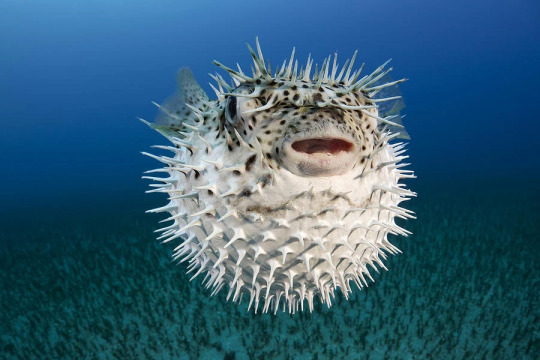
(image description: an inflated porcupinefish)
Unlike their counterparts, Qwilfish is always inflated, but can grow even bigger where in the real fish, inflation is stressful and only done when in danger. The line’s poison typing comes from real pufferfish having some incredibly potent poison. It’s called tetradotoxin and it’s an extremely dangerous neurotoxin. Fugu fish famously has to be prepared by a well-trained chef who knows what parts to cut away to avoid poisoning whoever eats it. Pnlike real puffers, Qwilfish can inject the poison into others through its spines, making it venomous as opposed to the real ones, who are poisonous. Overqwil also seems to have some sea urchin elements with how huge its spines are. Some urchins are also venomous and can inject poison through their quills. Finally, the whole line seems to be based off of naval mines what with their roundness and ability to explode.
Remoraid is a fish of many talents and has a lot of origins. First things first, it’s a pistol. This is more easily seen in its unused older design, but you can still see it. This is also why it evolves into an octopus. Octillery is an artillery cannon. Also the animals they’re based on both use suction and squirt water. Remoraid also has major inspiration from the archerfish (remember them?) in that it is a master at spitting water with precision and the pokedex says it can shoot targets out of the air just like an archerfish.
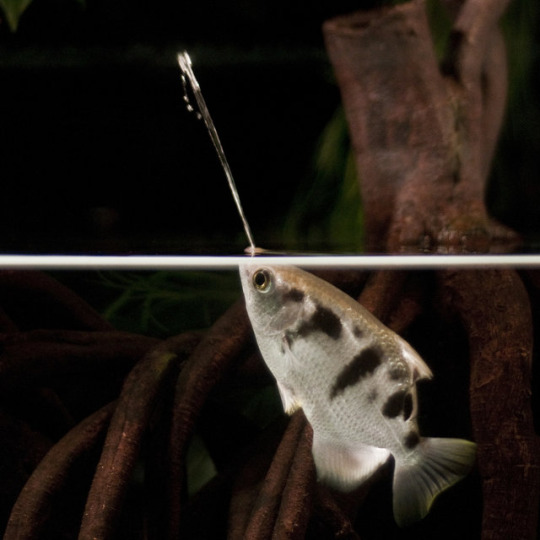
(imager description: a spitting archerfish)
The archerfish inspiration and pistol design are why it learns so many shooting moves. Finally, Remoraid is a remora, even though they really look nothing alike. Like the remora, it has a modified dorsal fin shaped like a suction cup that it uses to suction onto larger animals. Both remoras and Remoraid will get carried along by the larger animal and will eat scraps of the larger animal’s meal. The remora benefits by getting a free ride, water over the gills, and food while the larger animal may also get some benefits from the remora eating ectoparasites and dead skin. A remora attaching to an animal would either be a commensal (one party benefits, the other receives neither benefit nor harm) or mutualistic relationship. In Pokémon, the only animal we see Remoraid attaching to is Mantine and they have an explicitly mutualistic relationship as Remoraid fights alongside Mantine and its presence allows Mantyke to evolve. Speaking of which…

image description: a mana ray with two remoras attached to it
Mantyke and Mantine are stingrays, specifically manta rays, one of my favorite animals. They truly are gentle giants and these Pokémon are too, being primarily special walls. Like mantas, Mantyke and Mantine are intelligent, social, and playful creatures. Mantas are one of if not the smartest fish, smart enough to pass the mirror test by recognizing their own reflections. There is a correlation between animal intelligence and playfulness. The smarter an animal is, the more likely it is to play for fun rather than for hunting practice and other purposes. This can be seen in primates, corvids, canines, and yes, rays. Those antennae on Mantyke and Mantine are based on the cephalic flaps of the manta, modified fins that help direct plankton into its mouth. Of course these two have the flying type and unlike Gyarados, there’s a good reason for it. Mantas are part of the genus Mobula and all 9 species of the genus are known to leap out of the water before splashing back down.
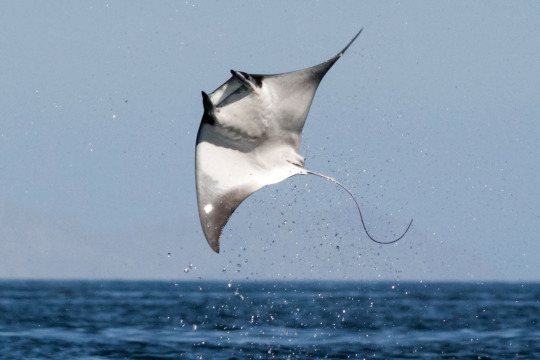
(image description: a Mobula ray jumping)
Nobody really knows why they do this, but there could be several reasons: cleaning parasites, herding prey, finding lost members of the school, or maybe just for fun. Mantine’s flying abilities are highly exaggerated and it also has some airplane design features, with the Remoraid on its wing looking like a plane engine or wing-mounted gun. As mentioned above, Remoraid and the Mantyke line have a mutualistic relationship. Not really relevant but still a fun fact: mantas give live birth and the babies come out folded up like burritos.
That’s it for part one. Come back next time for generations III and IV
105 notes
·
View notes
Note
Tell me about the fish you saw snorkeling please :)
Oh my GOD I nearly burned my self with my coffee when I saw this. Thank you so much for asking, but also you've opened the flood gates because it just so happens I am about to dump so many fish on you. While I primarily study freshwater fishes, I am a lover off all things aquatic, so here we go (all these images are from the internet):
Parrot fish galore and HUGE ones at that. The biggest one I saw looked like this. I don't know my scarids very well, but I do know that I saw a bumphead parrotfish. So funny looking. I was honestly surprised by how all the fish out there are CONSTANTLY nipping at the corals, but the current was pretty strong so we all had to swim a lot. It makes sense that they always need to be eating. I had no idea life on the reef was so turbulent
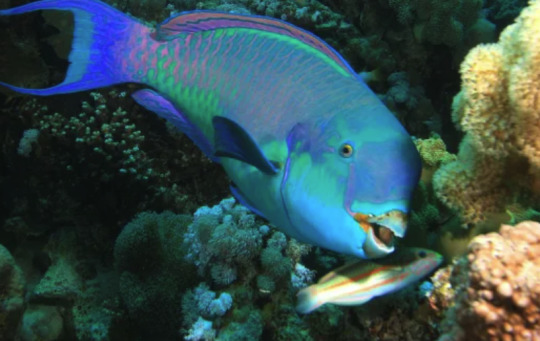
A lot of acunthurids. No blue tangs but plenty of brown ones and some unicorn tang! The ones I saw had really small humps.

So the common name for acunthirds is surgeonfishes because they have these sharp, blade like spines on their caudal peduncle called a scalpel. You can see it a bit more clearly on the Clown Unicornfishes (which were my fave cause the colors were so bright). Here they're the bright orange processes near the tail.
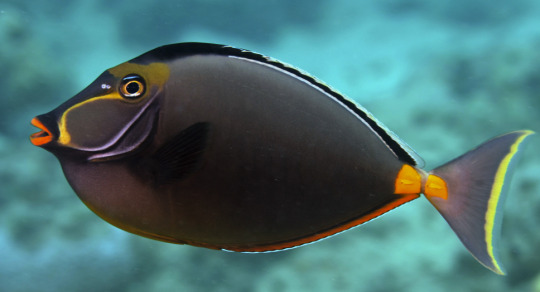
Wrasses. SO many wrasses. We saw birdnose wrasses with their long snoots, moon wrasses that were as colorful as rainbow lorikeets. My favorite were the cleaner wrasses following all the big parrotfish around and eating their ectoparasites,
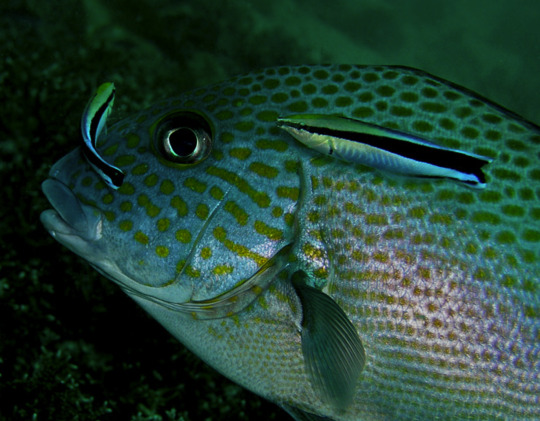
I saw a moray!! That was the most unexpected find for me. I was the only one in my group to see one, but it was so far out that the crew working the sailboat had to call me back in 😅 It was brown and spotted black and looked just like this guy. I didn't actually see his head, but I saw his long long body. He was huge!!

Some gobies hiding in their holes. Apparently some species of goby have a mutualistic relationship with shrimp. The shrimp digs a series of tunnels in the sand and the goby stands sentinel at the entrance. The shrimp then maintains contact with the goby with its long antennae so that it knows if the goby moves or startles when predators are nearby.
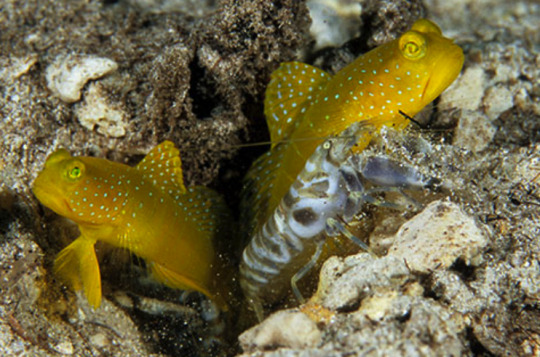
The goatfish was probably my second favorite find after the moray because I had no idea they were out there. Goatfish have two long chin barbels covered in tastebuds that they use to probe along the sand in search for prey. They are quite dextrous barbels too. They flick em around so fast!
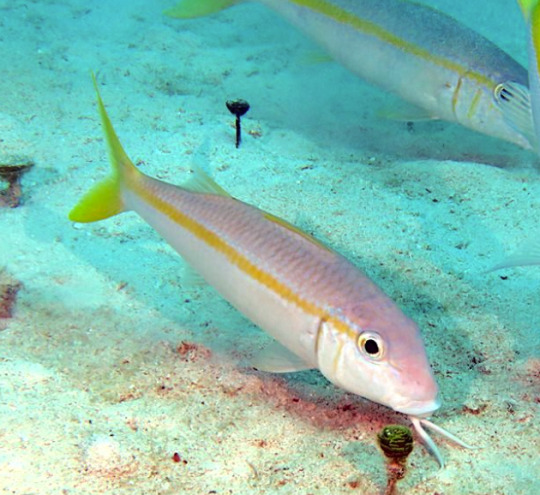
I got stung by something! it whipped me across the face pretty much 20 minutes into the water and it felt long and filamentous so i thought maybe it was some stray strand of anemone or jellyfish with active nematocysts. The crew member said it was likely a small jelly so woohoo! I got stung by a jelly on the great barrier reef :D
Triggerfish. Iw as hoping to see more tetraodonotiforms like puffers or filefish or a cowfish maybe, but I'm glad I still got to see at least one representative of the order cause they are among the most bizarre groups of fishes

This Moorish Idol that looked exactly like Gill from finding nemo
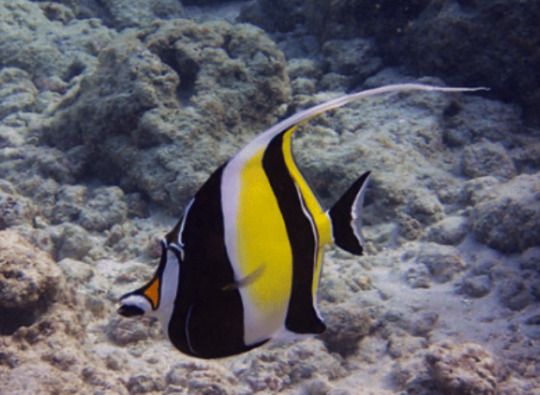
Lemonpeel angelfish, bluegirdle angelfish, emperor angelfish, you name it.


a lot of chaetodontids too. As I said, I don't study marine fishes so all the butterfly fishes looked so similar to me XD most of them were some combination of white, yellow, and black with their characteristically tall bodies and narrow snouts.


Giant clam!!! THEY WERE SO BIG. And so colorful. The movement of their spiracle truly hypnotized me.

Alright. That's all I got time for at the moment, as I need to pack and head up to the rainforest for the last leg of my trip. I'm sure I have forgotten dozens of fish already XD Thank you for attending my show and tell and for expressing interesting. Truly, I'm living any biologists dream rn, and I couldn't be more grateful for the opportunity to visit such a beautiful part of the world 🥲
25 notes
·
View notes
Link
#spotted unicornfish#Short-nosed Unicornfish#(Naso brevirostris#Naso brevirostris#pacific ocean#indian ocean#intotheblue.it#intotheblue#dive#snorkeling
0 notes
Video
Einhorn-Hornbader - Naso brevirostris - Spotted Unicornfish by Stefan Köder Via Flickr
0 notes
Photo

Have had more encounters with fish in this past month than in my life likely! This probably deserves a spot on the grid. Fish for breakfast, lunch, dinner and fish to share with all the neighbours. Sashimi for days (and days). How many ways can you cook fish? Seems the best way is to not cook it. Fresh is best. I haven't really seen fish this big, caught, and then cut. Quite the experience! Mahi mahi, Wahoo, Marlin, Tuna, Unicornfish. #pacificfish #greatescape #vanuatu #fiji #monsterfish https://www.instagram.com/p/Cj5TP5_Ju5X/?igshid=NGJjMDIxMWI=
0 notes
Note
What are you most looking forward to about your trip? What's your top must do for people who have never bee there before?
I'm most looking forward to seeing my friends. My top must-do's that is a tough one, Nonny, so how about a don't do instead? Don't waste money on a snorkelling excursion. They're overpriced, environmentally sketchy, and to be honest, Maui has lots of great spots right off its beaches. By the time the tourist boats get to where they're going (like Molokini), it's 1) too late in the day, and 2) too crowded, and everything you're wanting to see has already been scared away. You'll see like 3-5 different types of fish max, black triggerfish, Mamos, some type of butterfly fish, and maybe a unicornfish.
1 note
·
View note
Text
Sea-beasts seen:
Green sea turtles!!!
Moray eels
Magnificent snake eel
Black durgon triggerfish
Picasso triggerfish
Reef triggerfish (Humuhumunukunukuapua’a)
Pink-tail triggerfish
Achilles tang
Yellow tang
Moorish idol
Unicornfish
Convict surgeonfish
Raccoon butterflyfish
Ornate butterflyfish
Longnose butterflyfish
Threadfin butterflyfish
Peacock grouper
Red pencil sea urchins
Black spiny sea urchins
Sergeant-majors
Parrotfish
Bird wrasse
Other wrasse
White-spotted pufferfish
Trumpetfish
Filefish
0 notes
Photo

Colorful sea life from the Indian Ocean! From top to bottom: Sculptured Slipper Lobster (Parribacus antarcticus), Spotted Unicornfish (Naso brevirostris), Sharpnose Pufferfish (Genus Canthigaster), and Blue Swimming Crab (Portunus pelagicus). #SciArt by Louis Renard for his Poissons, Ecrevisses et Crabes (1754). Taxonomy tags come from Fishes, Crayfishes and Crabs: Louis Renard's Natural History of the Rarest Curiosities of the Seas of the Indies (1995) by Professor Theodore W. Pietsch. Contributed for digitization by Ernst Mayr Library, Museum of Comparative Zoology, Harvard University to #BiodiversityHeritageLibrary. http://www.biodiversitylibrary.org/page/50095173 ~~~~~~~~~~~~~~~~~~~~~~~~~~~~~~~~~~~~ #Lobster #Crab #Fish #Ichthyology #InvertebrateZoology #Invertebrates #Ocean #IndianOcean #Sea #BHLib #Biodiversity #NaturalHistory #Biology #ScientificIllustration #ScientificArt #OpenAccess #LibrariesofInstagram #Libraries #SciArtFix
#crab#fish#invertebrates#biodiversity#sciartfix#scientificart#librariesofinstagram#ocean#sciart#openaccess#invertebratezoology#libraries#bhlib#biology#ichthyology#indianocean#scientificillustration#naturalhistory#biodiversityheritagelibrary#lobster#sea
14 notes
·
View notes
Photo

Pulau Hatta | Banda Berada sekitar 25 Km ke arah timur dari Kepulauan Banda, alam bawah laut Pulau Hatta istimewa! Di spot Atol Skaru, terdapat koral-koral tempat tinggal dari berbagai spesies ikan yang cantik. Seperti Unicornfish, Ikan Jack dan Rainbow Runners, Whitetip Sharks yang punya panjang hampir dua meter, Kura-kura Sisik, Dogtooth Tuna, dan Napoleon Wrasse Photo Souce : https://www.instagram.com/rahmadlarae24/ — at Maluku. #tourism #maluku #paradise #tour #indonesia #natural #beach #beautiful #diving #snorkeling https://www.instagram.com/p/BtMwWygjiBj/?utm_source=ig_tumblr_share&igshid=1kc6fuhtkh4c7
0 notes
Text
9 Best Place To Do Scuba Diving [2020]
Before you begin reading this blog, we would suggest that you check out the amazing tour services we provide. Adventure destinations in India and decide on the best one which suits you the maximum — The Greatest Adventure Lies Ahead: Top Adventure Destinations In India. It’s high time you escape your comfort zone to possess unforgettable incredible and exciting experiences. You will be given a memory that will last for a lifetime by the thrill.
Adventure and all of the water infants junkies out there to find the destinations that are ideal for a scuba diving encounter in India. We have picked out 10 destinations to choose from — it’s time to locate your one and pack your bags for a memorable experience. The coral life is currently waiting to have explored by you — nothing could beat on the underwater experience. We promise you, it will alter your life.
A. Andaman And Nicobar
It’s a heaven for those people residing on the sea and uncovers the beauty of this world. It’s among the most gorgeous places. The amazing corals and coral reefs will leave you awestruck — you will be amazed to see the underwater fauna which includes Turtles, Manta Rays, Moray Eels, and Batfish — there’s so much waiting for you. The Best Scuba Diving places in Andaman and Nicobar as follows:
1. Swaraj Deep
It is 50kms from Port Blair, the life here will make you squint as it includes — Lionfish, Humpback Parrotfish corals, and rare fishes. These will be the few sites in Havelock Islands — Ocean Dive Centre, India Scuba Explorers, Blue Corals Dive, and Eco Divers.
2. Corruption Rock
It situated 57kms away from Port Blair and is located between Chidiyatappu and Rutland Island. This island is famous for its marine life including eagle rays and Unicornfish. As the sight consists of a rock that’s 14, it’s popular — a part of it’s sticking out of the water and the height is around 30 meters.
3. Lacadives
One has to take a boat from Wandoor to attain. It’s untouched by tourists which function as one of the sights for scuba diving in Andaman and Nicobar islands and makes it more heavenly and beautiful. May and December look to be an ideal moment to scuba dive here since the water is a lot calmer.
Other Diving Spots In Andaman And Nicobar: Passenger Island, Snake Island and Neil Island
Best Time To Scuba Diving — October to April
B. Goa
If you don’t amaze this place is ideal for all the aqua lovers. Goa is a paradise for water sports experience fanatics. An individual may have a thrilling experience not just experiencing one of other adventure sport but also the best watersports. It is unquestionably one of the adventure tourism destinations in India. Scuba Diving in Goa will surely get your attention as the submerged life gets the most exquisite flora and fauna that includes — sergeant-major puffers, lion-fish, scorpion-fish, surgeon-fish, barracuda, tuna, and eels. The Greatest Scuba Diving Spot at Goa is Grand Island:
4. Grande Island
It’s located several kilometers from the Mormugao peninsula, an individual can take a boat ride from the Bogmalo beach to reach this water heaven. It’s very best to experience scuba diving and investigate fascinating life with your naked eye. Do not forget to uncover Davy Jones Locker and Suzy’s Wreck — it’s better since the water currents are very strong here if a professional scuba diver explores these shipwrecks. For freshes, one can go for Uma Gumma Reef — whether it is your second or first dive since the water is calm at this diving site.
Other Greatest Diving Spots In Goa: Candolim and Sao Gorge Island
Best Time For Scuba Diving — October to Mid May
Price Per Dive In Goa — Rs. 3,000–5,000
C. Karnataka
By witnessing the magnificent underwater flora and fauna, this town is blessed with lovely coral and coral reefs, you’ll be mystified. One can spot colorful fishes whales, Turtles, Stingrays, and Stonefish if scuba diving is your passion. Netrani Island is the best spot.
5. Netrani Island
It is essentially full of coral reefs a coral island and other aquatic animals. It is located about 10 miles apart from Mudreshwar. Feel free to be friends with these aquatic water buddies including butterflyfishes, fish, and eels and do not be shocked to encounter a whale. This island has a lot of steep stones therefore that it’s a good idea to go diving with a boat.
Greatest Time For Scuba Diving In Karnataka — December, and January
Cost Per Dive In Karnataka- Rs. 5,000–6,000
Trekking Calendar For Indian Experience Junkies: 12 Treks For 12 Months
Your Backpack Is Incomplete Without These 12 Trekking Essentials
Your Backpack Could Make A Trek Or Break Up A Trek: The Way To Pack For Trekking
With the latest facilitation regarding Scuba Diving, Kerala has become one of the famous areas for Scuba Diving. Kovalam and Varkala shore serves as one of the best scuba diving spots in Kerela. Get to know more about the best one:
6. Kovalam
Kovalam situated in the center of Kerala which is about 16km from the popular major city of Thiruvananthapuram. They use an underwater scooter instead of the traditional scuba diving gear. The marine fauna comprises — pufferfish, groupers, boxfish, sergeants, pipefish and cherry fish. The best party about this diving site is that it has calm waters which makes it a much site for Scuba Diving for tourists.
Best Time To Scuba Diving In Kerela- December, and January
Cost Per Dive In Kerela — Rs. 5,000–6,000
7. Lakshadweep
At Lakshadweep see the coconut palms, blue lagoons, white beaches, along with the sparkling coral reefs and dip into the water amidst the beauty of marine life.
8. Bangaram
It’s a place situated in the stadium of Lakshadweep Island — surrounded by coral reefs, it’s also regarded among the greatest beaches in India — what are you waiting for? You found the best scuba diving destination. Being one of the cleanest and best makes it much easier to learn more about the underwater marine life.
Other Greatest Scuba Diving Spots In Kerela — Laccadives and Aggati Islands
Greatest Time For Scuba Diving In Kerela- October To March
Cost Per Dive In Kerela — Rs. 4,000–7,000
9. Pondicherry
Another one of the greatest destinations for scuba diving in India, Pondicherry has established a name for itself too — It provides sites such as The Temple Reef, Aravind Wall, and 4Corners are one of the very best diving spots in Pondicherry. The hottest one still stays — The Coral Shark Reef.
This is only one of the locations for scuba diving in Pondicherry’s arms — the property of beautiful beaches. There is a variety of the pros going for Scuba Diving and height in 5m to 40m for the convenience of the novices. This place is a home to different species of sharks such as Sicklefin Lemons Tawny Nurses, Grey Reefs, Blacktip Reefs, Whitetip Reefs, Silvertips, enormous Bulls, and the occasional Tiger.
Best Time For Scuba Diving In Pondicherry — March To October
Cost Per Dive In Pondicherry — Rs. 3,800–6,000
0 notes
Text
Best Scuba Diving in Pulau Weh
Tiny Pulau Weh (Weh Island) sits just off the northwestern tip of Sumatra, across the bay from Banda Aceh, which suffered great damage in the earthquake and subsequent tsunami of 2004. Although this small island does still bear some scars from the disaster, there is still much to offer travelers. Stop first at Kilometer Zero, the furthest west point of Indonesia and where this country begins. And the scuba diving in Pulau Weh means it really is a true paradise for divers. Despite its size, there are over 30 dive centers, which means you’ll have no trouble finding the right one for you.
There’s plenty to do topside as well, with waterfalls, volcanoes, idyllic beaches and coastlines to explore, along with picturesque, small villages and nature reserves.
If you’re looking for a lesser-known diving destination for your next vacation, Pulau Weh could be just the right fit.
How to get there
Until a few years ago, getting to Pulau Weh was not easy. It was quite isolated with little to no connection to the mainland. Nowadays, however, it’s easy to catch a flight to Banda Aceh from some of the surrounding countries and cities including Kuala Lumpur (Air Asia), Jakarta (Lion Air) and Penang (Firefly). Once you arrive in Banda Aceh, you can take a ferry to Pulau Weh. Ferries connect twice a day, so keep this in mind when booking a flight to Banda Aceh.
Once you get to Pulau Weh, Iboih Beach is a great place to stay. There are a number of restaurants with lots of western and local choices. Don’t forget to bring cash — there are no ATMs on Iboih Beach. Some of the dive centers accept cards, but call or email in advance and check directly with them.
How is the diving in Pulau Weh?
There is a whole range of diving on Pulau Weh to suit all levels of diver. Technical divers can try the Sophie Rickmers This deep dive dive requires decompression and deep training. Advanced divers, who enjoy fast-moving currents should check out Shark Plateau. If you’re looking for something a slower-paced and want to get up-close-and-personal with the marine life, then there is plenty for you to see as well. The waters surrounding Pulau Weh are teeming with marine life, large and small.
When is the best time for diving in Pulau Weh?
If you’re looking for maximum visibility and a huge quantity of marine life, the best time to dive in Pulau Weh is during the dry season from April through October. Dive sites are brimming with life during this time. If you travel to Pulau Weh during the wet season, remember that the waters can be extremely choppy, with some dive centers stopping their trips around this time as it can get quite dangerous.
Here are our top picks for the best dive sites in Pulau Weh.
The Canyon
This spectacular dive site is one of the top three in Pulau Weh. It is located at the northeastern point of the island and is the closest to Kilometer Zero. Here you’ll find large, sandy patches of underwater landscape and a deep wall, covered in gorgonians that drop to around 197 feet (60 m) below. At the start of the wall, you’ll find a cave/small overhang. As you travel the east, you’ll reach two large rock formations at 33 to 98 feet depth (10 to 30 m), separated by two canyon channels. Floating through the channels is a lovely experience and provides much-needed relief from the currents and a chance to slowly observe marine life.
The Canyon prominently features dogtooth tuna, trevally, jackfish, unicornfish and barracuda. It is quite common to see a number of sharks as well. When looking at the wall, keep an eye out for porcelain crab, starry puffers, scorpionfish and titan triggerfish. This dive site is best for advanced divers due to the strong currents.
Underwater Volcano
Divers usually visit the Underwater Volcano site alongside another site called the Sabang Wreck. Located on the eastern side of the island, the waters here are unusually warm due to the high thermal activity and rising bubbles. Marine life that enjoys the warm water, such as soft-shell crabs, is common at this site. This dive site can be on Underwater Volcano is a great site for all levels of diver.
Sabang Wreck
The Sabang Wreck is a tugboat lying close to the shoreline. This is the perfect choice for a second dive after visiting Underwater Volcano. You’ll find a huge variety of healthy hard and soft corals attached to the wreck, as well as a picturesque reef located nearby. This dive is perfect for newbies but all divers will enjoy it.
Sophie Rickmers
The Sophie Rickmers is an impressive wreck dive, stretching for approximately 440 feet (134 m) in a sheltered bay away from strong currents. The cargo ship was one of five confiscated by the Dutch in May of 1940, but the German crew scuttled the vessel so as to keep it from Dutch control. This decompression dive requires a lot of experience. Open-water divers can dive this wreck, however they must have a minimum of 100-plus logged dives and be familiar with decompression procedures. The decks are located at 148 feet (45 m) and the bow is at 180 feet (55 m).
Limbo Gapang
This great dive site is located to the east of Underwater Volcano. This shore dive can range anywhere from a shallow dive to a deep dive, depending on the dive operator you choose. You’ll never see the same thing twice at Limbo Gapang, which is teeming with marine life. If you’re planning on doing a diving courses while visiting Pulau Weh, then this is the perfect spot. Easy conditions also make for a fantastic night dive. Tropical fish abound here, so make sure to bring an underwater camera.
Photos and article by guest author Torben Lonne, Editor-in-Chief at DIVEIN.com.
The post Best Scuba Diving in Pulau Weh appeared first on Scuba Diver Life.
from Scuba Diver Life http://bit.ly/2MgmwCD
0 notes
Text
Best Scuba Diving in Pulau Weh
Tiny Pulau Weh (Weh Island) sits just off the northwestern tip of Sumatra, across the bay from Banda Aceh, which suffered great damage in the earthquake and subsequent tsunami of 2004. Although this small island does still bear some scars from the disaster, there is still much to offer travelers. Stop first at Kilometer Zero, the furthest west point of Indonesia and where this country begins. And the scuba diving in Pulau Weh means it really is a true paradise for divers. Despite its size, there are over 30 dive centers, which means you’ll have no trouble finding the right one for you.
There’s plenty to do topside as well, with waterfalls, volcanoes, idyllic beaches and coastlines to explore, along with picturesque, small villages and nature reserves.
If you’re looking for a lesser-known diving destination for your next vacation, Pulau Weh could be just the right fit.
How to get there
Until a few years ago, getting to Pulau Weh was not easy. It was quite isolated with little to no connection to the mainland. Nowadays, however, it’s easy to catch a flight to Banda Aceh from some of the surrounding countries and cities including Kuala Lumpur (Air Asia), Jakarta (Lion Air) and Penang (Firefly). Once you arrive in Banda Aceh, you can take a ferry to Pulau Weh. Ferries connect twice a day, so keep this in mind when booking a flight to Banda Aceh.
Once you get to Pulau Weh, Iboih Beach is a great place to stay. There are a number of restaurants with lots of western and local choices. Don’t forget to bring cash — there are no ATMs on Iboih Beach. Some of the dive centers accept cards, but call or email in advance and check directly with them.
How is the diving in Pulau Weh?
There is a whole range of diving on Pulau Weh to suit all levels of diver. Technical divers can try the Sophie Rickmers This deep dive dive requires decompression and deep training. Advanced divers, who enjoy fast-moving currents should check out Shark Plateau. If you’re looking for something a slower-paced and want to get up-close-and-personal with the marine life, then there is plenty for you to see as well. The waters surrounding Pulau Weh are teeming with marine life, large and small.
When is the best time for diving in Pulau Weh?
If you’re looking for maximum visibility and a huge quantity of marine life, the best time to dive in Pulau Weh is during the dry season from April through October. Dive sites are brimming with life during this time. If you travel to Pulau Weh during the wet season, remember that the waters can be extremely choppy, with some dive centers stopping their trips around this time as it can get quite dangerous.
Here are our top picks for the best dive sites in Pulau Weh.
The Canyon
This spectacular dive site is one of the top three in Pulau Weh. It is located at the northeastern point of the island and is the closest to Kilometer Zero. Here you’ll find large, sandy patches of underwater landscape and a deep wall, covered in gorgonians that drop to around 197 feet (60 m) below. At the start of the wall, you’ll find a cave/small overhang. As you travel the east, you’ll reach two large rock formations at 33 to 98 feet depth (10 to 30 m), separated by two canyon channels. Floating through the channels is a lovely experience and provides much-needed relief from the currents and a chance to slowly observe marine life.
The Canyon prominently features dogtooth tuna, trevally, jackfish, unicornfish and barracuda. It is quite common to see a number of sharks as well. When looking at the wall, keep an eye out for porcelain crab, starry puffers, scorpionfish and titan triggerfish. This dive site is best for advanced divers due to the strong currents.
Underwater Volcano
Divers usually visit the Underwater Volcano site alongside another site called the Sabang Wreck. Located on the eastern side of the island, the waters here are unusually warm due to the high thermal activity and rising bubbles. Marine life that enjoys the warm water, such as soft-shell crabs, is common at this site. This dive site can be on Underwater Volcano is a great site for all levels of diver.
Sabang Wreck
The Sabang Wreck is a tugboat lying close to the shoreline. This is the perfect choice for a second dive after visiting Underwater Volcano. You’ll find a huge variety of healthy hard and soft corals attached to the wreck, as well as a picturesque reef located nearby. This dive is perfect for newbies but all divers will enjoy it.
Sophie Rickmers
The Sophie Rickmers is an impressive wreck dive, stretching for approximately 440 feet (134 m) in a sheltered bay away from strong currents. The cargo ship was one of five confiscated by the Dutch in May of 1940, but the German crew scuttled the vessel so as to keep it from Dutch control. This decompression dive requires a lot of experience. Open-water divers can dive this wreck, however they must have a minimum of 100-plus logged dives and be familiar with decompression procedures. The decks are located at 148 feet (45 m) and the bow is at 180 feet (55 m).
Limbo Gapang
This great dive site is located to the east of Underwater Volcano. This shore dive can range anywhere from a shallow dive to a deep dive, depending on the dive operator you choose. You’ll never see the same thing twice at Limbo Gapang, which is teeming with marine life. If you’re planning on doing a diving courses while visiting Pulau Weh, then this is the perfect spot. Easy conditions also make for a fantastic night dive. Tropical fish abound here, so make sure to bring an underwater camera.
Photos and article by guest author Torben Lonne, Editor-in-Chief at DIVEIN.com.
The post Best Scuba Diving in Pulau Weh appeared first on Scuba Diver Life.
from Scuba Diver Life http://bit.ly/2MgmwCD
0 notes
Photo

Strange Fishes from the Deep — Spotted Unicornfish and More https://ift.tt/2CKcKYq
0 notes
Photo

Spotted Unicornfish, Spotted Surgeonfish - high resolution image from old book.
0 notes
